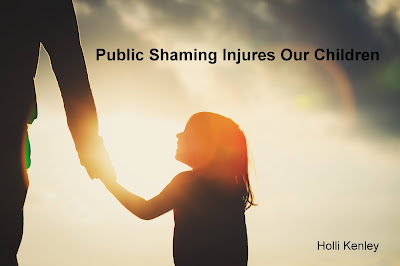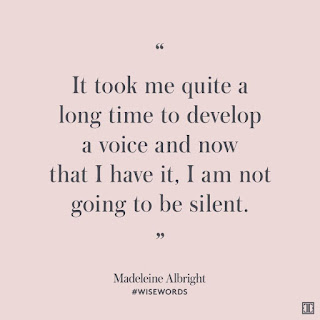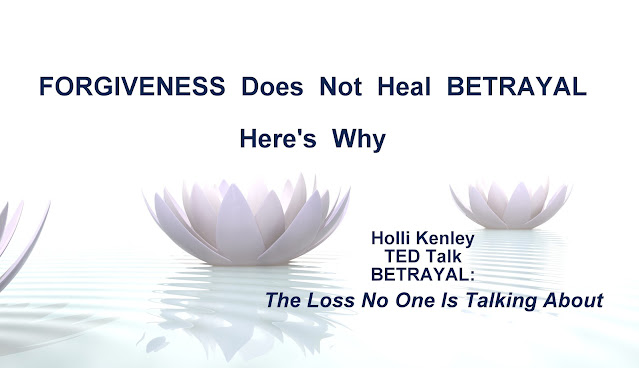Public Shaming - Part One: Two Costly Casualties
Shaming. It has been around for a very long time. It has been in our homes, our schools, our places of work, and in just about every environment which tolerates it and even those which try desperately to tackle it. For over a decade, shaming has taken on a life of its own through social networking sites and through electronic forms of communication. Shaming has gone viral. Tragically, Public Shaming has become a normative behavior. Although we have known about two of the most common motivations for Public Shaming - to instill fear and to incite division among individuals - we are reluctant to speak honestly about the most deeply consequential effects of Public Shaming. Today's post will do so as we address Two Costly Casualties. And in Part Two, we will offer some considerations for it's elimination as we explore Two Restorative Responses.
2 Costly Casualties of Public Shaming: Our Children and Our Human Condition
Our Children
Children learn from their environments. Although in generations past, children's primary source of influence and impact came from their primary caregivers, today's children are heavily influenced by their degree of access to technology and where and with whom they spend time online. Online interactions inform children about behaviors which are acceptable or tolerated. Over time and with the repetitive nature of public shaming, children are conditioned to its usage; and without timely corrective measures in place, children will replicate those behaviors. In addition to learning shaming behaviors, children are reactive. Their decisions are driven by their feelings and emotions. Cognitively, they have not yet developed the ability to analyze, discern, or evaluate the consequences of their choices. Thus, when they are hurt, many defensively and impulsively lash out at others.
Not only are children learning to shame, but Public Shaming is also impacting our children's mental health. Shaming is a form of abuse similar to bullying or cyber bullying.
This is important.
Our children being impacted from the effects of Public Shaming. Tragically, they are learning it is a normative behavior, they are reacting to it, and they are suffering from it.
Our Human Condition
When we speak of the Human Condition, we are talking about "how we are as humans." We are speaking about our "human nature." Of course, each individual is unique; however, the Human Condition encompasses shared qualities which contribute to our humanity and our need to connect. A healthy Human Condition is one which embodies qualities such as kindness, courage, compassion, belonging, etc.
The Human Condition is always changing and evolving. However, for nearly two generations, we have been communicating and interacting socially predominately through electronic means. The ease with which we can connect is wonderful! At the same time, the ease with which Public Shaming has found its way into our discourse with its ensuing destructive path is due to two important dynamic factors in our relationship with technology: anonymity and power differential.
When we communicate indirectly (behind a screen), we feel a sense of anonymity. Although we may know or know of the other person (or not at all), because we are protected behind a screen, it frees us up to behave in ways we would not normally behave. In short, we feel "emboldened." In addition, when we are behind a screen, we develop a sense of being "empowered." Why? Because we do not need to be bigger, stronger, better, faster, or out-number another person. By the swipe or tap of a "key," we can effectuate harm against another individual.
This is important.
Today, I went to Amazon to purchase a book. Because I know very little about it or the author, I read a few reviews. There were beautiful comments. And there were nasty, mean, demeaning reviews. It is important to be honest in our critiques; however, I kept asking myself why reviewers felt the need to publicly shame the author. Then, I reminded myself of what I have learned about human nature and the dynamics of anonymity and power differential. In addition, research has validated that individuals who repeatedly and chronically shame others through their electronic communications navigate from a mindset of moral disengagement. In other words, they are detached from the feelings and emotions of another human being. Tragically, their Human Condition lacks the capacity to care about how their actions and words may impact another individual.They are incapable of feeling empathy.
Whether it is on an Amazon or Google review or any of the millions of shaming attacks tweeted, retweeted, posted, uploaded, etc.through social networking sites or electronic platforms, the deepening erosion of Our Human Condition is another costly casualty.
The viral nature of Public Shaming is harming Our Children and Our Human Condition. And yet, we have it in our power to eradicate this toxic behavior. However, it requires that each of us decides whether we want to be part of the ongoing problem or if we want to partake in its solution. It's as simple as that.
Coming soon - Public Shaming Part -Two: Two Restorative Responses
Until then, take a peek at our series From Self-Shaming To Becoming Enough - Week One
2 Costly Casualties of Public Shaming: Our Children and Our Human Condition
Our Children
Children learn from their environments. Although in generations past, children's primary source of influence and impact came from their primary caregivers, today's children are heavily influenced by their degree of access to technology and where and with whom they spend time online. Online interactions inform children about behaviors which are acceptable or tolerated. Over time and with the repetitive nature of public shaming, children are conditioned to its usage; and without timely corrective measures in place, children will replicate those behaviors. In addition to learning shaming behaviors, children are reactive. Their decisions are driven by their feelings and emotions. Cognitively, they have not yet developed the ability to analyze, discern, or evaluate the consequences of their choices. Thus, when they are hurt, many defensively and impulsively lash out at others.
Not only are children learning to shame, but Public Shaming is also impacting our children's mental health. Shaming is a form of abuse similar to bullying or cyber bullying.
This is important.
Bullying (or cyber bullying) is an intentional, aggressive act carried out by a group or individual for the purpose of inflicting harm on another individual.
Shaming is a deliberate, aggressive behavior carried out by a group or individual for the sole purpose of devaluing another individual.
As much as some folks may want to minimize shaming as a behavior that everyone does or blame victims for not being able to "toughen up," children do not have the cognitive capacity to brush off disgusting, degrading, derogatory attacks. They are sensitive, tender beings who want desperately to belong. When they are teased, taunted, belittled, and berated, they feel it deeply and intensely. They internalize it as though "something is wrong with me." Studies have found that the more time children (and adults) spend online, the more unhappy they are.
(Common Sense May 2016 Executive Summary "Technology Addiction")
Since 2011,there has been a rise in the increase of depression among tweens and teens. Evidence suggests that our children internalize feelings of inadequacy through social comparison and experience shaming in the form of social exclusion. In 2018, the American Academy of Pediatrics (AAP) adjusted its guidelines suggesting that healthcare professionals screen all teens ages 12 years and older for depression.( "American Academy of Pediatrics Announces New Guidelines to Screen Children for Depression," 2018) As reported by the Cyberbullying Research Center in August, 2018, rates of suicide and suicidal attempts also have risen sharply among our youth, with a strong correlation to bullying and cyber bullying. Children are also suffering with higher rates of anxiety and stress, fearful of being targeted by anyone at anytime.
(Common Sense May 2016 Executive Summary "Technology Addiction")
Since 2011,there has been a rise in the increase of depression among tweens and teens. Evidence suggests that our children internalize feelings of inadequacy through social comparison and experience shaming in the form of social exclusion. In 2018, the American Academy of Pediatrics (AAP) adjusted its guidelines suggesting that healthcare professionals screen all teens ages 12 years and older for depression.( "American Academy of Pediatrics Announces New Guidelines to Screen Children for Depression," 2018) As reported by the Cyberbullying Research Center in August, 2018, rates of suicide and suicidal attempts also have risen sharply among our youth, with a strong correlation to bullying and cyber bullying. Children are also suffering with higher rates of anxiety and stress, fearful of being targeted by anyone at anytime.
Our children being impacted from the effects of Public Shaming. Tragically, they are learning it is a normative behavior, they are reacting to it, and they are suffering from it.
Our Human Condition
When we speak of the Human Condition, we are talking about "how we are as humans." We are speaking about our "human nature." Of course, each individual is unique; however, the Human Condition encompasses shared qualities which contribute to our humanity and our need to connect. A healthy Human Condition is one which embodies qualities such as kindness, courage, compassion, belonging, etc.
The Human Condition is always changing and evolving. However, for nearly two generations, we have been communicating and interacting socially predominately through electronic means. The ease with which we can connect is wonderful! At the same time, the ease with which Public Shaming has found its way into our discourse with its ensuing destructive path is due to two important dynamic factors in our relationship with technology: anonymity and power differential.
When we communicate indirectly (behind a screen), we feel a sense of anonymity. Although we may know or know of the other person (or not at all), because we are protected behind a screen, it frees us up to behave in ways we would not normally behave. In short, we feel "emboldened." In addition, when we are behind a screen, we develop a sense of being "empowered." Why? Because we do not need to be bigger, stronger, better, faster, or out-number another person. By the swipe or tap of a "key," we can effectuate harm against another individual.
This is important.
Over time and with the repetitive nature of our electronic behaviors and without any meaningful repercussions or timely accountability in place, the Human Condition becomes more emboldened and more empowered, and thus, more likely to shame again.
Today, I went to Amazon to purchase a book. Because I know very little about it or the author, I read a few reviews. There were beautiful comments. And there were nasty, mean, demeaning reviews. It is important to be honest in our critiques; however, I kept asking myself why reviewers felt the need to publicly shame the author. Then, I reminded myself of what I have learned about human nature and the dynamics of anonymity and power differential. In addition, research has validated that individuals who repeatedly and chronically shame others through their electronic communications navigate from a mindset of moral disengagement. In other words, they are detached from the feelings and emotions of another human being. Tragically, their Human Condition lacks the capacity to care about how their actions and words may impact another individual.They are incapable of feeling empathy.
Whether it is on an Amazon or Google review or any of the millions of shaming attacks tweeted, retweeted, posted, uploaded, etc.through social networking sites or electronic platforms, the deepening erosion of Our Human Condition is another costly casualty.
The viral nature of Public Shaming is harming Our Children and Our Human Condition. And yet, we have it in our power to eradicate this toxic behavior. However, it requires that each of us decides whether we want to be part of the ongoing problem or if we want to partake in its solution. It's as simple as that.
Coming soon - Public Shaming Part -Two: Two Restorative Responses
Until then, take a peek at our series From Self-Shaming To Becoming Enough - Week One
For more healing resources, visit Holli Kenley
Amazon Author
Follow us on Instagram or Twitter
Like us on Facebook
Amazon Author
Follow us on Instagram or Twitter
Like us on Facebook
Parents and Guardians, do you need some help? It's here!!






Comments
Post a Comment